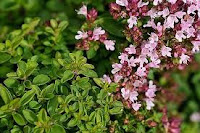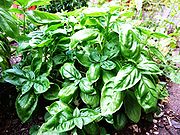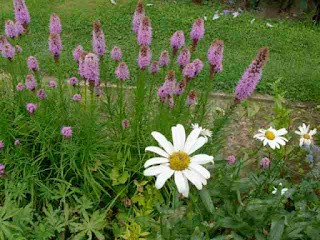My Simple Garden
Sunday, September 15, 2024
TIPS FOR GROWING VEGETABLES
Thursday, July 14, 2022
Planting Zones: What are they?
Temperature Zones for Planting
Above: Yellow Yarrow is a native plant that is very hardy.
STOP buying plants that you only like for the color or size. Do your research, find out their hardiness and then make the purchase. Many people have expressed to me about perennials they bought only to have the plant die over a cold winter. That is why you must check labels and tags for the zone they will live in for extreme conditions.
Each area of your specific country or area has a zone. Check with your own countries agricultural hardiness rating to find out your zone. It is based on the warmest and coldest temperatures. The coldest it gets in winter is the most important to consider. Plants that are semi-tropical can tolerate nights of a temperature with a low of 10C but will not survive in most of the colder winters. So the hardiness zone is defined by an average annual minimum temperature. This is important for the survival of many plants otherwise you will be replacing your perennials every year.You might as well grow annuals from seed and save a lot of money.
I live in Ontario, Canada so depending on where that location I can research my zone on the Canadian Hardiness chart to see what types of plants I can safely leave outside. In order for my perennials ability to survive the harshest weather here, I need to know the ZONE. It is between 6 and 7 here in Southern Ontario, depending on the region. The plants must be able to tolerate cold, wind, drought, flooding and heat. With selected breeding, you can pick hardy plants by purchasing seeds of those varieties that will survive best. Check the tags at local garden centers to find those able to fit in your zone safely.
Generally I pick woody stemmed plants, native species and small shrubs or evergreens. Once they are mature they can withstand temperatures as low as -40C. Try some of these if you want very hardy plants. Salvia, Mints, Sedum, Shasta Daisy, Day Lily, Veronica, Oriental Poppy, Peonies, Russian Sage, Sea Thrift and Yarrow. Ornamental grasses, Native Plants and Wildflowers are a good choice to add too. Note: Perennials do fine in large planters or pots, but you will need to bury the pots outside in the ground to overwinter them. Dig the trench or hole deep enough to cover the top of the pot or simply remove the entire root ball and sink it into the ground in October. If your plant has doubled or tripled in size it's a good time to divide it while preparing it for winter.
Russian Sage
.
Sunday, November 21, 2021
Healing Properties of Plants
For many hundreds of years people have used herbs for their healing properties. These are some of the common herbs, their uses and how to grow them. The essential oils in these plants are chemical compounds commonly extracted from the plants for use in aromatherapy. Today the oils are popular for use in soap and candle making and the dried herbs for teas and natural vitamins.
SAGE: Improves memory. It is an easy versatile herb often referred to as a cure-all for its expectorant, disinfectant and anti-fungal properties. Sage can be used orally as a tea, gargled for sore throat and to flavor food. This perennial will grow in any soil type, is drought tolerant and only requires a mostly sunny location. Sage is a good companion for most all vegetables.
THYME: Promotes good health. It was used for its expectorant and disinfectant properties to clean wounds, relieve gas and sore throats and flavor food. Tea made with the flowers is still used today as a herbal remedy. Thyme is available in many colors and flavors like lemon thyme, easy to grow in the garden or in pots.
YARROW: Increases awareness. It grows wild in regions of America, Europe and Asia. The flowers are white, yellow or red with feathery leaves and pungent fragrance. Many insects like moths, butterfly, beetles, and wasps are attracted and feed on this plants. In the middle ages this yarrow was used to heal wounds or stop nosebleeds. According to Chinese tradition it considered lucky to hang it up dried to bless a house or for ceremonies. Yarrow is an easy to grow plant that requires very little care, is drought tolerant, and is a good companion in any garden to repel pests and attract beneficial insects. Plant yarrow near any plants to protect.
CHIVES: Helps boost Immune system. Chives is high in vitamin C and iron. The flower, stems and bulbs are edible with a mild onion flavor. It can be dried, pickled or eaten fresh on food. It aids in digestion for tea or added to a meat, rice, potato or pasta dish. It's a simple plant to start from seed, grown in pots all year round indoors, is a perennial outside and will add lovely purple blooms in early summer to a vegetable or herb garden. A companion for carrots, grapes, tomato.
DILL: Sharpens the Mind. Since the beginning, mankind has cultivated this popular aromatic herb. It soothes upset stomach, expels gas, freshens breathe. Dill is commonly known now as a flavoring for pickles, fish and potato chips. This herb is easy to grow from seed is drought tolerant in gardens or pots. Let it dry and self seed on its own or collect the seeds to grow fresh dill every year. Plant as a companion with cabbage, lettuce and onion.
PARSLEY: Overall Protection. Parsley can be steeped in a cup every day as a beneficial tea to aid in digestion. It can aid with coughs and colds used as a throat gargle. Best used fresh if possible but dried also can be added to many food dishes. Parsley is simple and easy to grow fresh from seeds indoors in pots all year round. During the spring and summer you can place it outside as a good companion to lettuce, cabbage, carrot.
LAVENDER: Good for overall Health. It's known for its relaxing scented properties. As an oil it's popular in aromatherapy to treat headaches and anxiety. The essential oils in lavender are still used for bath and laundry products, candles and air fresheners. This easy to grow herb requires a simple trimming in early spring and with flower on new growth. TIP- Cut back the branches on a mature plant to about 6 or 8 inches in May. Harvest by hanging bundles up to dry in a warm, dark place. Often it will re-flower in late summer again. Use dried in sachets for linen closet, wreaths or bath balls mixed with salts.
MINTS: Improves and sharpens the conscious mind. All mints are excellent companion plants in gardens or on porches and decks. They attract many beneficial insects while repelling pests like ants and harmful beetles. These pests hate the strong smell of mint due to its high essential oil content. Some mints are invasive if planted directly in the ground; TIP- place in a large pot and sink the pot in the ground. They work well in large planters, barrels or pots so you can move them around. Growing mint only requires that they are not over-watered and get at least six hours of sun a day. Mint has been long used as an aid for heartburn, stomachache, headache and nausea. Use fresh mint to steep as tea for migraines, gas, bloating, and insomnia. There are many types, but the most common are spearmint, peppermint, lemon mint. Wild mints like Bergamot (monarda) also known as bee balm is used to flavor Earl Grey tea. Both monarda and catnip grow in open fields, ditches and meadows. Great planted around all plants in general as a companion plant.

BASIL: Promotes peace and happiness. It works as a sedative, aids digestion, relieves headaches, colic, coughs and ear infections. Rub fresh basil leaves on a bug bite to stop itching.When dried it's good in cooking for pasta, soups, pizza and much more. Used freshly chopped it's the main ingredient in pesto sauce. Basil has an intense amount of concentrated oil and the flavor will increase when heated so beware how much you use. It's an easy to grow annual: from seed start indoors any time and by June place pots out in the garden as a companion plant for beans, cabbage and tomato. The strong fragrance repels pests to protect plants from insects who feed on your crops. Grow basil fresh each year and harvest leaves before it flowers.
Wednesday, November 10, 2021
Common Pests and how to recognize them
Common Pests and How to Recognize Them
Aphids
They group together in a dense clump and suck sap from young growth and leaves. There will be a sticky coating on leaves along with a black sooty mold. They are sometimes green, yellow, brown or black. They spread viruses to other plants around your garden. This can be a serious problem if left untreated.
CONTROL: Check plants, like roses, weekly and spray with garlic based insecticidal soap regularly.
Leafminers
They are small, but don’t do a lot of serious damage. They feed on leaves by burrowing inside and can be seen a pale green trails or white lines. This is unsightly but not too serious.
CONTROL: Spray both front and backs of leaves of infected
plant or remove damaged leaves and throw away into garbage, not compost pile.
Red Spidermites
They are small, but can cause a lot of damage, because the suck sap out of plants, cause stunted growth, causing leaves to curl and drop. They leave fine webs on plants, so watch for this a first sign of trouble. Attact grapes, mums, carnations, and cucumbers.
CONTROL: Spray with insecticidal soap regularly.
Earwigs
They are about 1 inch long, fast moving and have pincerlike tail. You can trap them easily using old pop bottles or dishes of a sweet yeast mixture. 1 cup water, 2-3 tsp. sugar, and ½ tsp. granular yeast. They eat holes in most any kind of plant, but like hostas and vegetables best. They are a nuisance and will devour young plants too.
CONTROL: Be vigilant with traps by checking and refilling them every 2 or 3 days to reduce their numbers.
Scale insects
They look like a small brown blister on stems and leaves. They suck sap from plants, cause leaves to drop and can kill a whole shrub over a season of two if not stopped.
CONTROL: Prune off dead or damaged branches. Dormant oil can be used in spring. A carbaryl like Sevin can be sprayed and is effective when insects are in the crawling stage.
Slugs and Snails
Slugs have long tubular bodies, while snails are similar but they have round shells. They both leave a slimy trail, eat holes in leaves and feed on young seedlings. They can do a lot of damage if not controlled. They feed mostly on hosta and food crops.
CONTROL: You can place a circle of egg shells, tin foil or use copper wire around urns and pots to stop them. They will not cross over anything sharp and the tin and copper will give off a mild electrical shock so this will deter them. Laying bottle traps with beer/yeast mixture as a lure works well. They will crawl in and drown.
Wireworms
They are about ½ inch long, yellow in color and do damage to underground to roots, rhizomes and bulbs. Once they attack a plant it will collapse above ground. They like to feed on iris, potato, carrot, beets.
CONTROL: A granular insecticide can be added if you are converting grassland to garden use, otherwise you must wait to plant 3 years to use the soil. When adding compost, keep a lookout for them and hand pick to keep under control.
Cutworms
They are fat white/gray color worms, hide just below the soil surface and feed at night in May and June. They eat roots of anything in their path.
CONTROL: Use protective collars, placed around seedlings. For lawn damage spray with diazinon insecticide.
White Grub worms
Grubs are the larvae of the June Bug Beetle and damage lawns and most other garden plants by cutting the stem off just below the soil surface. They multiply quickly, so always be on the lookout for problems.
CONTROL: A lawn can safely be sprayed each year to control them before they become a problem. If you see small dead patches of grass, lift a section of turf, inspect the soil down about 5-6 in. and remove any grubs by hand before they become a problem.
Cabbage worm
They are seen often as a white butterfly or pale green caterpillar feeding on cabbage, broccoli, cauliflower. They eat holes in leaves and tunnel into cabbage heads, usually just feeding on anything in the cabbage family.
CONTROL: Use insecticide dust or spray early to control breeding of the white butterfly and laying of eggs on plants.
Thursday, September 24, 2020
Blooms in autumn
Even in September and October you can still have many plants in bloom if you plan ahead. The taller Sedum Autumn Joy is in its glory along with fall asters, some varieties of hosta, clematis, roses and some annuals too. Many perenial plants that are trimmed and deadheaded also re-flower at this time of year. Coreopsis daisy, day lily and lupine all will keep sending up new leaves and bloom a second time if they are trimmed back and deadheaded as well as watered.
Monday, June 29, 2020
Perennials for July
Many of the early blooming plants from spring don’t like the hot dry conditions of July and will begin to die back. They will sacrifice leaves, flowers and stems during drought to send all their water and energy to the roots. It’s a survival instinct so the plant will grow again. Simply cut back the dry leaves and wait for rain to come. Often the plants will send up a few new ones later in the summer when the rains return. Typically, many a flowering plant can sense when it's in a drought and so it will bloom earlier than normal. The flowers are often short lived and last a week or two, then it begins to set seed. The hot temperatures trigger this need to finish blooming so it will propagate.
The bright colours of coreopsis daisy and Shasta daisy are typical for July. Yellow day lily, purple Liatris, and some varieties of hosta all begin to bloom in early summer. Astilbe and purple coneflower are all beginning to come into their own as the days heat up.
InWednesday, June 24, 2020
Variegated Plants
Variegated foliage can add color and interest to a shade garden because of their stripes, patterns, spots, streaks, veining or frilly edges. Their are many types of plants like shrubs, trees, herbs, annuals and perennials that all have different kinds of variegated foliage. They can add light to a dark shady spot or be planted in amongst darker plain leafy plants. MINT: Some mints have splashes or edges of white, some have dark veins that make them stand out. Apple mint, pineapple mint, salvia or sage, thyme and oregano all come with interesting variegated leaves.
TREES and shrubs like Dogwood and Maple, as well as shrubs like Laurel, Barberry, Euonymus, Box, and Ivy all have some type of variegated form. They tend to be smaller in size but don’t grow as vigorously as the plain leaf varieties often do.
ANNUAL plants are usually grown indoors for house plants and many are varieties are available in variegated form. Swedish ivy, pathos, coleus, scented geraniums, citrus trees, impatience, and African daisy are all good ones to try both indoors and out.Perennials include the ornamental grasses, ground covers, and herbaceous non woody plants that all return every year to form large clumps and then die back in winter. Ribbon grass, moor grass, cord grass, and zebra grass add height and have stripes or banding on the foliage. Streaked and spotted plants like lungwort, figwort, goutweed, and lily of the valley are all catch the attention and brighten up your yard. Sedum, daylily, giant iris add cottage garden charm and height with colors of yellow, gold and white.




































